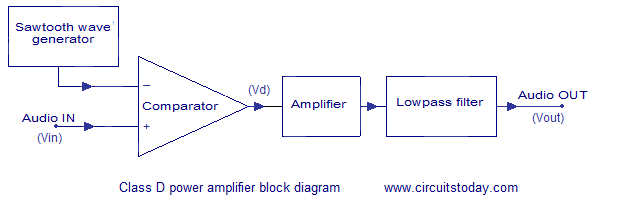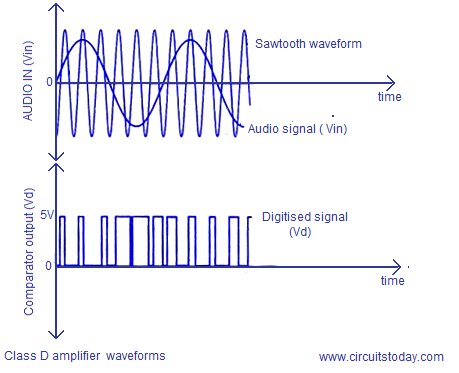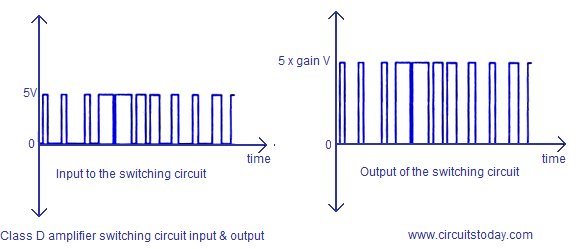Class D power amplifier.
Class D power amplifier is a type of audio amplifier were the power handling devices are operated as binary switches. Since the power handling devices (MOSFETS) works as perfect binary switches, no time is wasted in between the transition of stages and no power is wasted in the zero input condition. Class D power amplifiers are much power efficient when compared to its predecessors like Class A, Class B and Class AB. Out of the list the most efficient Class AB only have a maximum theoretical efficiency of 78.5%. In practical scenario with real speakers as load, the efficiency of Class AB amplifiers can drop as low as 50%. At the same time a well designed Class D amplifier with real speakers as load will never go below 90% in terms of efficiency. The theoretical efficiency of a Class D amplifier is the ideal 100%.
An ideal binary switch will pass all current through it with no voltage across it when it is ON. When it is OFF the entire voltage remains across it and no current will flow through it. This means no power is wasted across the switching element which does the amplification, and it accounts for the unbelievable efficiency of the Class D amplifier. Conversely, the class AB amplifier will always have some current passing through and some voltage remaining across the switching element.
Higher efficiency means low thermal dissipation and it means it dissipates less power when compared to the predecessors (The Class A, Class B, Class AB and Class D). Since Class D amplifiers are highly power efficient, they require a smaller heatsink and a smaller power supply. Smaller heatsink and smaller power supply reduces the size and it is the main advantage of a Class D amplifier. Class D amplifiers have become very popular in applications like hand held audio devices, portable home theaters, mobile phones etc where all in these cases output must be decent (in terms of power and fidelity) and the size must be as small as possible. Class D is the only option for combining all these requirements together.
A typical Class D power amplifier consists of a sawtooth waveform generator, comparator (based on an OPAMP), switching circuit, and a low pass filter. The block diagram of a Class D amplifier is shown in the figure below.
Sawtooth waveform generator.
The sawtooth waveform generator generates a high frequency sawtooth waveform for sampling the input audio signal. The frequency of the sawtooth waveform is usually selected 10 times the maximum frequency of interest in the input audio signal.
Comparator.
The main job of the comparator is to digitize the input audio signal by mixing it with the chopping sawtooth waveform. The result of this mixing will be a digital copy of the analog input signal. The low frequency components of the digital signal will represent the input audio signal and the high frequency components of the digital signal are of no interest. Input and output waveforms of the comparator are shown in the figure below.
Switching circuit.
Even though the output of the comparator is a digital representation of the input audio signal, it doesn’t have the power to drive the load (speaker). The task of the switching circuit is to provide enough current and voltage gain which is essential for an amplifier. The switching circuit is generally designed around MOSFETs. Input and output waveforms of the switching circuit are shown in the figure below.
Low pass filter.
The task of the low pass filter is to filter out useful low frequency components from the output of the switching circuit. The output of the low pass filter will be a scaled replica of the input audio signal. Negative feedback loops are often included in between the low pass filter output and the comparators audio input in order to fight the errors.
Advantages of Class D amplifier.
- Low heat dissipation.
- Reduced size and weight.
- High power conversion efficiency. Almost all power drawn is supplied to the load.
Disadvantages of Class D amplifier.
- Requires a very clean and stable power supply.
- The high frequency response is dependent on the loudspeaker impedance.




Comments are closed.